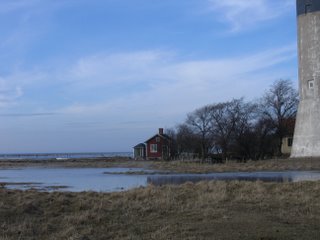Sunday, April 2: The big twitch
Raggna and Carl-Gustav joined us for a walk in a nearby forest. They meet friends there for a walk most weeks, and it's one of their favourite places on the island. The soft ground was covered with several layers of last year's leaves and frequent deposits from the fallow deer. The deer pellets can be as much as six months old, since their decay is suspended by the winter snow cover. The rocks and bases of the trees were covered in lichen and bright green moss. The lichen also spread over most of the leafless grey trees in a strange parody of the snow that was there a few months ago. Again, my photos haven't done the landscape justice, I think I messed up the light and shade. If adjusting the camera setting to 'landscape', auto-focussing and pushing the big button won't do the trick then I'm out of ideas.



I continued to enjoy the quiet forest for the next 20 or so minutes, but eventually I noticed that Johan was getting edgy. He wanted to get going for that king eider. We said good-bye to Raggna and Carl-Gustav, and Johanna spent some time coaxing soggy Astrid away from the puddles and into the car.
We headed to a small and not-so-picturesque industrial harbour. The birding scene was in full swing:

Before I'd even walked to the boot of the car and decided whether or not to climb into my borrowed ski pants, I twitched a new call: flock of birders spotting a rarity. The king eider was here! Johan was hastily setting up his 'scope, I grabbed my bins, jogged over and set them on the flock everyone else was looking at. It had just passed and any identifiable markings were diminishing with distance every second. In the excitement, Johanna kindly translated the directions from the others into English. "It's about half-way along the line, a bit smaller than the others. Can you see it, the one that's smaller?" Already they were too far away for me to distinguish between the male and female common eiders (not usually a difficult task: the males are black and white, the females are brown), so I had no chance of seeing the pretty green patch around the king eider's eye. I thought I picked the one that was a little smaller than the others, but I couldn't be sure.
We stayed for about another hour. The eiders were passing closer to the shore here and the sunny weather allowed me to see their plumage more clearly, so I didn't tire of it as quickly as I expected to. I also sampled some Swedish licorice. I had heard several times before arriving in Sweden that the licorice here is different. Salty. Not good. Don't try it. I don't even like sweet licorice. It just appears in my life on special occasions when my mum or I make a birthday cake from the Women's Weekly cookbook and then I pick it off to eat the icing. But I did try the Swedish licorice and of course I hated it. Read it again, people: stay away from the Swedish licorice. The other 'typically Swedish' lollies were fine: peppermint-flavoured boiled lollies with red stripes. They looked and tasted like solid pieces of Macleans toothpaste. Maybe they were developed to eliminate the after-taste of the licorice?





